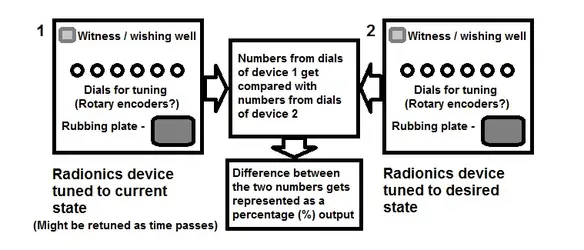HikuTechy
Temporal Novice
I was inspired by the divergence meter featured in Steins;Gate, the idea of it intrigued me.
So I started thinking about what it might take to make one in real life.
At its most basic, the divergence meter is measuring the difference between two lines, then it gives a percentage output of that difference.
Simple, right?
Well, there are some things to consider.
The lines should be time lines, as in they cannot go straight up or straight down on the graph or there be no output for the meter.
Thus, if the difference be completely 100% between the two lines, one of the lines would be in the top of the graph while the other would be in the bottom or they be inverse of each other. If there be no difference between the lines, the lines should match (as in be identical and give the same values).
Okay, so far so good. Now for the tricky part. In what way do we get said lines?
There are many ways to do this. We can have the meter measure the difference between any time lines that have events basically.
I started thinking, could we quantify the current world branch timeline and could we quantify other world branch timelines somehow?
Another way we could maybe do this is to quantify the current state somehow, like maybe the current state of some individual who's on a specific path and then specify a desired state of that individual to reach and then measure the difference between the two states. Okay so that's not exactly two lines per se. But the desired state may be a point on another line, which our state (which we should be able maybe measure with time thus forming a line) may then be measured against.
That's the initial basic idea of it. Maybe we'll figure something more out later.
So how do we measure the current state and the desired state?
One way to do this would be to use radionics.
I can apparently measure my current state, like when getting the values for my state for healing.
And then there's the idea of the wishing machine, which may give a desired state.
For my divergence meter, I thought about using edge lit displays.
They're a lot like nixie tubes, except more durable and easier to manage.
https://hackaday.com/2017/03/23/before-there-were-nixie-tubes-there-were-edge-lit-displays/
https://hackaday.com/2012/02/18/edge-lit-nixie-tube-is-sheer-brilliance/
So I started thinking about what it might take to make one in real life.
At its most basic, the divergence meter is measuring the difference between two lines, then it gives a percentage output of that difference.
Simple, right?
Well, there are some things to consider.
The lines should be time lines, as in they cannot go straight up or straight down on the graph or there be no output for the meter.
Thus, if the difference be completely 100% between the two lines, one of the lines would be in the top of the graph while the other would be in the bottom or they be inverse of each other. If there be no difference between the lines, the lines should match (as in be identical and give the same values).
Okay, so far so good. Now for the tricky part. In what way do we get said lines?
There are many ways to do this. We can have the meter measure the difference between any time lines that have events basically.
I started thinking, could we quantify the current world branch timeline and could we quantify other world branch timelines somehow?
Another way we could maybe do this is to quantify the current state somehow, like maybe the current state of some individual who's on a specific path and then specify a desired state of that individual to reach and then measure the difference between the two states. Okay so that's not exactly two lines per se. But the desired state may be a point on another line, which our state (which we should be able maybe measure with time thus forming a line) may then be measured against.
That's the initial basic idea of it. Maybe we'll figure something more out later.
So how do we measure the current state and the desired state?
One way to do this would be to use radionics.
I can apparently measure my current state, like when getting the values for my state for healing.
And then there's the idea of the wishing machine, which may give a desired state.
For my divergence meter, I thought about using edge lit displays.
They're a lot like nixie tubes, except more durable and easier to manage.
https://hackaday.com/2017/03/23/before-there-were-nixie-tubes-there-were-edge-lit-displays/
https://hackaday.com/2012/02/18/edge-lit-nixie-tube-is-sheer-brilliance/
Last edited by a moderator:



